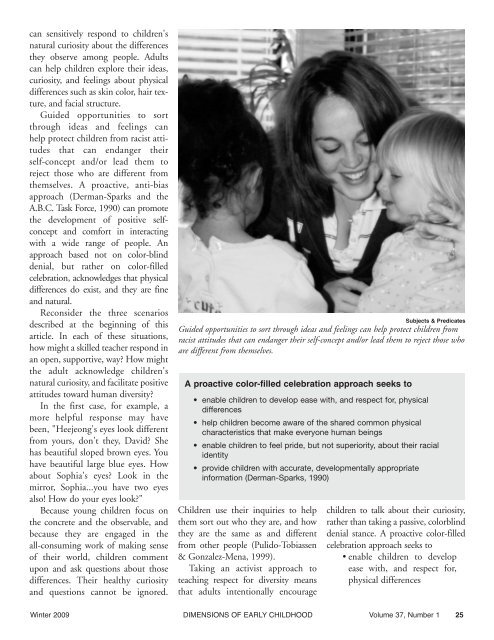their awareness of differences and to develop their - Southern Early ...
their awareness of differences and to develop their - Southern Early ...
their awareness of differences and to develop their - Southern Early ...
You also want an ePaper? Increase the reach of your titles
YUMPU automatically turns print PDFs into web optimized ePapers that Google loves.
can sensitively respond <strong>to</strong> children's<br />
natural curiosity about the <strong>differences</strong><br />
they observe among people. Adults<br />
can help children explore <strong>their</strong> ideas,<br />
curiosity, <strong>and</strong> feelings about physical<br />
<strong>differences</strong> such as skin color, hair texture,<br />
<strong>and</strong> facial structure.<br />
Guided opportunities <strong>to</strong> sort<br />
through ideas <strong>and</strong> feelings can<br />
help protect children from racist attitudes<br />
that can endanger <strong>their</strong><br />
self-concept <strong>and</strong>/or lead them <strong>to</strong><br />
reject those who are different from<br />
themselves. A proactive, anti-bias<br />
approach (Derman-Sparks <strong>and</strong> the<br />
A.B.C. Task Force, 1990) can promote<br />
the <strong>develop</strong>ment <strong>of</strong> positive selfconcept<br />
<strong>and</strong> comfort in interacting<br />
with a wide range <strong>of</strong> people. An<br />
approach based not on color-blind<br />
denial, but rather on color-filled<br />
celebration, acknowledges that physical<br />
<strong>differences</strong> do exist, <strong>and</strong> they are fine<br />
<strong>and</strong> natural.<br />
Reconsider the three scenarios<br />
described at the beginning <strong>of</strong> this<br />
article. In each <strong>of</strong> these situations,<br />
how might a skilled teacher respond in<br />
an open, supportive, way? How might<br />
the adult acknowledge children's<br />
natural curiosity, <strong>and</strong> facilitate positive<br />
attitudes <strong>to</strong>ward human diversity?<br />
In the first case, for example, a<br />
more helpful response may have<br />
been, "Heejeong's eyes look different<br />
from yours, don't they, David? She<br />
has beautiful sloped brown eyes. You<br />
have beautiful large blue eyes. How<br />
about Sophia's eyes? Look in the<br />
mirror, Sophia...you have two eyes<br />
also! How do your eyes look?"<br />
Because young children focus on<br />
the concrete <strong>and</strong> the observable, <strong>and</strong><br />
because they are engaged in the<br />
all-consuming work <strong>of</strong> making sense<br />
<strong>of</strong> <strong>their</strong> world, children comment<br />
upon <strong>and</strong> ask questions about those<br />
<strong>differences</strong>. Their healthy curiosity<br />
<strong>and</strong> questions cannot be ignored.<br />
Subjects & Predicates<br />
Guided opportunities <strong>to</strong> sort through ideas <strong>and</strong> feelings can help protect children from<br />
racist attitudes that can endanger <strong>their</strong> self-concept <strong>and</strong>/or lead them <strong>to</strong> reject those who<br />
are different from themselves.<br />
A proactive color-filled celebration approach seeks <strong>to</strong><br />
• enable children <strong>to</strong> <strong>develop</strong> ease with, <strong>and</strong> respect for, physical<br />
<strong>differences</strong><br />
• help children become aware <strong>of</strong> the shared common physical<br />
characteristics that make everyone human beings<br />
• enable children <strong>to</strong> feel pride, but not superiority, about <strong>their</strong> racial<br />
identity<br />
• provide children with accurate, <strong>develop</strong>mentally appropriate<br />
information (Derman-Sparks, 1990)<br />
Children use <strong>their</strong> inquiries <strong>to</strong> help<br />
them sort out who they are, <strong>and</strong> how<br />
they are the same as <strong>and</strong> different<br />
from other people (Pulido-Tobiassen<br />
& Gonzalez-Mena, 1999).<br />
Taking an activist approach <strong>to</strong><br />
teaching respect for diversity means<br />
that adults intentionally encourage<br />
children <strong>to</strong> talk about <strong>their</strong> curiosity,<br />
rather than taking a passive, colorblind<br />
denial stance. A proactive color-filled<br />
celebration approach seeks <strong>to</strong><br />
• enable children <strong>to</strong> <strong>develop</strong><br />
ease with, <strong>and</strong> respect for,<br />
physical <strong>differences</strong><br />
Winter 2009 DIMENSIONS OF EARLY CHILDHOOD Volume 37, Number 1 25
















